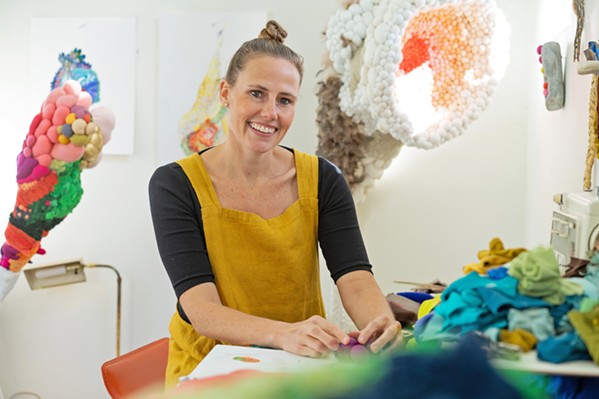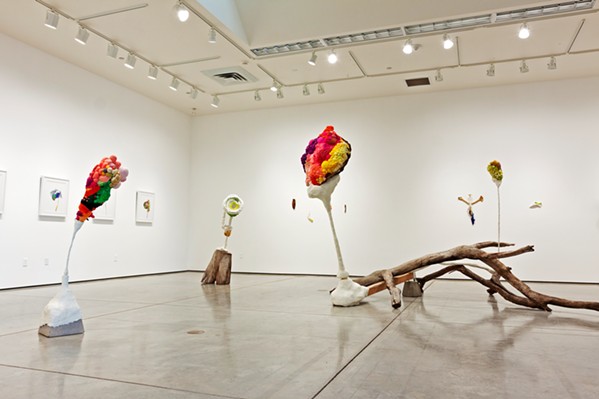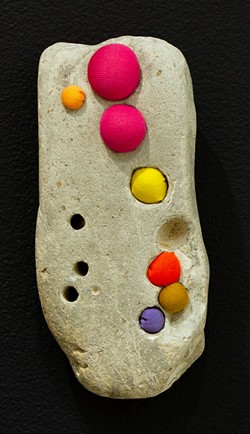Stuffing, folding, and binding. Manipulating forms and textures. SLO-based artist Sommer Roman mimics the lines and shapes of nature by giving used textiles a second life and incorporating them with man-made objects and items from the natural world.
"You change the scale, you change the color, you change a different fold. ... for me it's like a playground," Roman said. "A playground for my hands."
Roman's interested in the cross-section between human and plant—nature and animal—and using it as a way to understand our connection with the world around us. The materials she uses as a jumping off point have those ideas imbedded into them, she said. And everything in her current body of work displayed at Cuesta College's Harold J. Miossi Art Gallery has been a part of a human life.
The art pieces in Nobles Among Us give "new life to something that has a memory," she said.

- Courtesy Photo By Mariah Dingman
- TEXTILES QUEEN Sommer Roman uses discarded clothing and linens, objects from nature, toilet paper, mirrors, and domestic building materials to create pieces that link everyday life with the wild. Find more of her work at sommerroman.com and @sommerroman_studio on Instagram.
The Queen balances precariously above the gallery's polished cement floor. Bobbles of colored fabric meld into one another to form her giant head, held aloft by what appears to be a bone molded from paper clay: toilet paper, joint compound, and different flours. Alluring and beautiful, she holds court at the center of the room, with Roman's other pieces surrounding her.
It was the first piece Roman created for the show, and it's also the biggest. Three smaller sculptures encircle The Queen, perched over wood and cement blocks, standing between her and the smaller sculptures and plant-forms on paper hanging from the gallery's walls.
"Being the first one, it has the most commanding presence, and I feel like it commanded the rest of the work, being the largest one," Roman said, adding that The Queen is the matriarch of the show. "It's not a human; it's not a masculine force. ... It's something that's reversing what all of our modern society would say. It's more animal-, plant-like. It's feminine. It's made of fabric. It's soft and crafty and playful."

- Photo Courtesy Of Harold J. Miossi Art Gallery
- CONTEMPORARY CONTEMPLATION On display at Cuesta College's Harold J. Miossi Art Gallery, Sommer Roman's Nobles Among Us show ponders the connection between the man-made and natural worlds.
Gallery Coordinator Tim Stark said Roman's art is approachable in a way that a lot of contemporary art isn't. Her pieces have a playfulness to them and are familiar, comfortable to the viewer.
"They draw you in no matter what your level of understanding of contemporary art or art is. You just know that you're interested in it," Stark said. "They draw you in because you don't really know exactly what they are, and you don't really know why they're so cool. ... They kind of allude to something greater."

- Photo Courtesy Of Harold J. Miossi Art Gallery
- CONSTELLATION A Rock and fabric come together to showcase Sommer Roman's focus on turning color, textures, and shapes into something that evokes a sense of wonder in viewers.
They have a "wondrousness" about them, he said.
With a master's in fine arts from UC Santa Barbara, Roman has participated in shows all over the Central Coast and the world, including shows at the Wildling Museum in Solvang and Tretyakov State Gallery in Russia. She occasionally teaches art classes at Cal Poly and Westmont College and lives in San Luis Obispo with her husband and two small children. The solo show at Cuesta is her first in SLO, and all of the pieces in it were created specifically for Nobles Among Us.
"The thing that takes it beyond is that all of her work is underpinned by a solid, consecutive thought," Stark said.
She riffs on Descartes' famous quote, "I think, therefore I am," and is inspired by what biologist and philosopher Andreas Weber calls "poetic ecology."
Stark said that as she was making the work, she was also steeping herself in this "very rigorous theoretical background," reading Weber's work as she was creating her art.
"So she's making this work while also reading and thinking about these things directly," Stark said. "She's using it as a jumping off point to create work that's sort of investigating those ideas."
Without locking onto one material or one way of exploring an idea, Stark said Roman was willing to explore the idea of poetic ecology in many ways. With textiles, textures, man-made objects, natural objects, paint, paper, sculpture, hard edges, and soft edges, Roman created a world for us to explore.
"One basic principle that I grabbed from [Weber] was this sort of reordering of bringing human back into the fold of not necessarily being at the top of the food chain. ... Reordering our value in nature—kind of putting us back in our right place," she said. "In the end, at our core, we have a natural kinship with the natural world and other beings, and that's core to understanding our 'liveness.' That's what he says."
This idea of interconnectivity between beings—the mind and body, humans and animals, the man-made world and wild habitats—leads to reciprocity and mutuality between all life forms, Roman said. It's this feeling that she tries to encapsulate with her work.
In contemporary times, Roman said, the natural order is out of whack, and humans have a contentious relationship with nature. And she hopes that viewers can have a reflective experience as they walk through her show (she's even included some mirrors).
"That is maybe the core of my work and how, I, myself go about the world ... to understand one's self and our relationship to the other," she said. Δ
Editor Camillia Lanham is the queen of self-reflection. Send thoughts to [email protected].

Comments